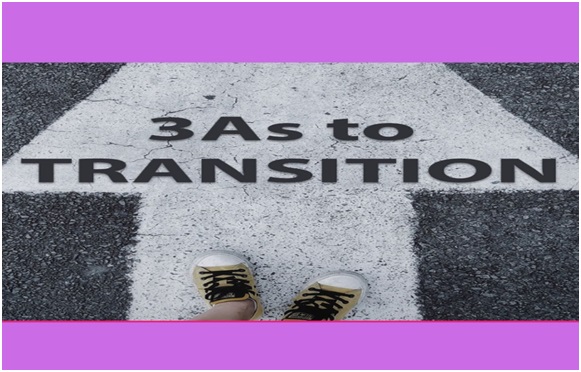A Coaching Model By Vineetha Valsa Kumar, Career Transition Coach, UNITED ARAB EMIRATES
Transition Fog

Change is an event and transition is the process you go through in response to the change- William Bridges
With every transition comes FEAR. Many consider this FEAR as a lack of confidence but during my few years of practice with my clients, I have noticed that this fear is due to a lack of CLARITY in oneself. Lack of clarity on our strengths, values, and passion.
I would like to explain the above with an analogy. We all know how to walk but if asked to walk in the dark although you are confident to walk you FEAR the dark because there is no light or rather clarity to where you are headed. I believe in making my clients self-aware of their strengths and the innate resources they carry with them to make their walk (transition) easier.
3 A’s to T (Transition)
Assessment: Uncover the Client’s Hidden Self
This is the stage of exploration. Assessment of the client’s internal and external world. This would involve assessments to explore their strengths, values, and personality. Understand the client in terms of their reason for this change, educational background, personal timeline, financial stability, and personal and family responsibilities.
I am the sole author of the dictionary that defines me- Zadie Smith
Awareness: Reflecting on the Client’s Passions and Gifts to Gain Awareness
- What energizes you and makes you ALIVE?
- What makes you lose track of your time?
- What activities come to you more easily than others?
- What do you get acknowledged for?
- What are the things that you do or think differently?
- How do you want to make a difference or impact in your career?
- How do you want to be remembered?
- What is most important to you in your career?
The client after having reflected on the above questions would then be encouraged to talk to his family members, friends, and colleagues about his strengths and gifts that they think stands are most important while defining the client.
At this stage, the client then brainstorms his/her top 5 values, strengths, and skills/gifts. They are then asked to circle the core values that they are not honoring and what they can do to start honoring them? The client is asked to create 3 career purpose statements based on the reflections.
Action: This Is Where the Rubber Meets the Road
- The goal here is to explore various careers that are meaningful, fulfilling, and aligned with the client’s strengths, values, passion, and skills/gifts.
- The client prepares a laundry list of all the jobs that they think fit with their identified strengths, passion, and skills
- The client then narrows them down and eliminates options that do not align with their purpose statement. At each step, the client is reminded that this is not a test and there is no one correct answer and those we are exploring.
- This is the point the client explores in depth the NON – Negotiable
- What is stopping you from moving forward?
- What are you afraid of?
- What can be the worst-case scenarios?
- Consider your lifestyle factors, opportunities for growth, and earning potential against your option
- Rate the selected options on a scale of 1 to 10
Transition: Change Is the Only Constant
Based on the above exploration the client sets to revamp their personal brand. At this stage, there is a bit of coaching and consulting as the client develops his /her personal brand. The client works on their resume; LinkedIn profile and digital presence that will help reflect their personal brand. While making a decision on their career path this is an excellent opportunity for them to position themselves both on paper and online.
- When you meet someone at a professional event, what do you want them to remember about you? (Elevator pitch)
- What are the most important aspects of your experience that you want others to know?
With the above as the base, the client tries to revamp their resume, LinkedIn profile, and online presence.
Finally, the client reflects on the following question:
- What has become clearer?
- What awareness or insights have happened in these few sessions?
- How will this be used to move forward?
- What support is expected from the coach from this point?
The two most important days of your life are the day you are born and the day you find out your WHY- Mark Twain
Learn How to Create Your Own Coaching Model
Your Coaching Model reflects your values,
philosophies and beliefs and must communicate who you will coach
and the problems you will solve. Read more about creating your coaching model
References
Essential career transition coaching skills – By Caroline Talbott
Career coach – By Corrine Mills
